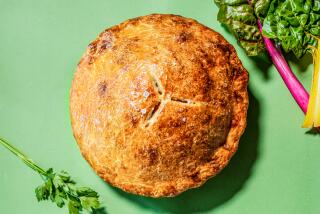Pigeon peas: A sweet summer addition to the edible garden
- Share via
For gardeners who lament the arrival of summer because it means pea season is over, consider the venerable pigeon pea -- a hardy perennial that can produce successive harvests during the year. The sweet, fresh green peas (technically beans) are a doppelganger for petit pois, and they’re also nitrogen-fixing plants, enriching the soil.
The pigeon pea (Cajanus cajan), whose cultivation can be traced back more than 3,500 years, is known by a variety of names: Congo pea, Angola pea, red gram -- postmarks of its travels as it spread from eastern India to Africa and the Middle East. In Barbados, it was used to feed pigeons.
Midsummer is when the yellow-red flowers appear, attracting flocks of hummingbirds. Soon after, clusters of fuzzy twisted pods appear, packed with brown speckled seeds that can be eaten fresh when green, when they most resemble peas.
Dried, pigeon peas are a main ingredient in Indian dals, Caribbean and African rice dishes, soups and stews. They are sometimes paired with green mango and fresh coconut. As beans, they need to be soaked and cooked for an hour or two. The taste is nutty and the texture crisp -- a vegan’s bacon, say some.
“When they’re dry, you boil them longer,” says the West Indian native who goes by the name Mackadoo at Vermont Square Community Garden in Los Angeles. “My mother cooked chicken and rice and peas all the time.”
When green, the entire pod can be eaten, master gardener Tamiko Nakamoto says.
“In the Caribbean they also eat the young shoots just coming up,” says Nakamoto, also a member of the Vermont Square garden.
True to their name, pigeon pea plants yield greens and protein-rich seeds that make for good chicken fodder while also providing shelter for cage-free birds. The roots are said to repel rodents, including rats.
Like other legumes, pigeon peas do better when seeded directly in the ground, 1 inch deep. Soak them overnight before planting. If you want to sprout the peas so that you later can plant only the healthiest specimens, soak the seeds and leave them in a plastic bag in a warm spot. Seeds are easily available online through sources such as Purcell Mountain Farms.
Pigeon peas have a deep tap root and can handle semi-dry conditions, but they produce more with regular irrigation. It’s good interplanted with corn.
In commercial fields, pigeon peas are grown as annuals, but Vermont Square’s plant is about 4 years old, looking more like a tree and still fruiting vigorously. (In the best conditions, the plant can reach 15 feet tall.) It will continue pumping out pods for a few more years, gradually losing production.
This is a tropical forest plant, so it slows down in the winter -- just in time for green peas.
The Global Garden, our look at multicultural L.A. through the lens of its landscapes, appears here on Tuesdays.
JOIN THE CONVERSATION:@latimeshome | pinterest.com/latimeshome | facebook.com/latimeshome | facebook.com/latimesgarden





